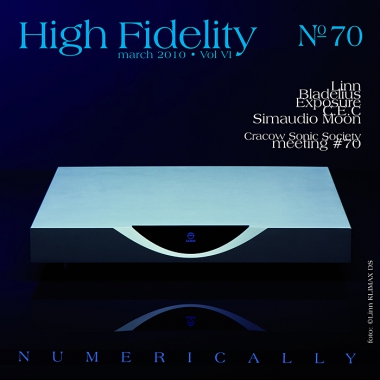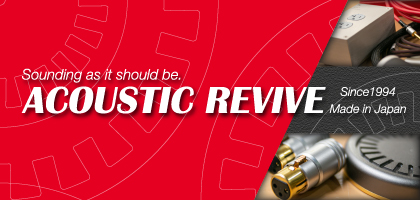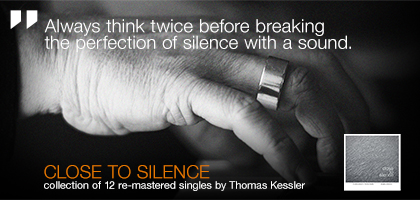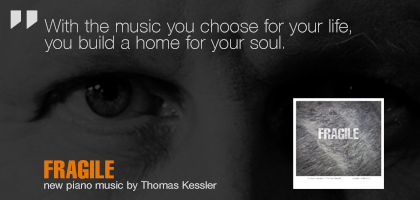BREAKING THE WAVES

We live in interesting times. Although the Chinese, who incorporated this sentence into a saying, wanted to warn us from something like this, but from my point of view, the point of view of a reader of magazines and books, music lover, audiophile, “interesting times” equal “good times”. Something is happening, what I can see with my own eyes, something that changes the paradigm, the editorial houses used to work with, both the “paper” and the disc ones. The change means transition from physical carriers to files. This is a change from the real to the virtual world, a change from something real to a stream of zeros and ones. But because we are used to having physical contact with a product, a book, a magazine, a newspaper, a disc, etc, this change is not as quick as it could be, and as it would seem from the “logic of times”. But the problem is not only the conservatism of the readers and music lovers, but also a very prosaic thing – the user friendliness of a newspaper, book or disc. The proposed solutions, related to the digital reproduction of those things, were far from ergonomic and could not convince the users.

Now this changes. With the appearance of convenient readers, the usage of Internet newspapers became much easier than before, and the information is updated on ongoing basis. Soon also Apple’s tablet will become available, which is destined to be a success, which adds the ability to read text, browse the Internet, watch films, listen to music, etc. In stereo and in color.
Similar problems to those the readers had (I am sorry for the past tense, but I want to indicate, that this is something happening now, something progressive), were also true for the music lovers and audiophiles. Servers used to collect disc data were big, noisy and clumsy. This is why those were not accepted by people, who were not computer geeks.

Here did also everything change, the moment first Linn and Naim file players were introduced. Those were conceived as a variation of a CD player, and were much easier accepted by those, who just wanted to listen to music. But still we do not have a critical mass here, because the technology placed inside those players is beyond the capabilities of most audio gear manufacturers. And audiophiles are not convinced even by the fact, that a file loaded in a flash memory or hard disk, sounds better, than the same material from a disc. Because mechanics is the bottleneck of any standard based on optical discs. But this is not all – only the file players are free from the “standard change” fear, and this is something, that kept all manufacturers awake at night. Because they needed to answer the question: is it profitable to invest in a new, expensive CD player? Or it would be better to make an SACD player? Or a universal player, including Blu-ray, otherwise it will be outdated. And this creates new problems. And this happens again and again. File players are a salvation, because they will play any kind of file, without “asking” what it is. And if something changes? Then a software update is enough, either automatic, from the net, or via a computer.

But again, the most important obstacle remains the human mentality and habits. Because being in contact with a physical carrier, a newspaper, a magazine, etc, is a one-of-a-kind experience. Probably our children perceive it differently, because for them downloading music is more natural than buying a disc. And when they get the option to download games from the Internet, and store them on disks, nothing will stop it. Maybe our generation has to pass, before everything changes…
But regardless how quick this change will happen, usage of readers/players must be easy, intuitive, otherwise they do not make sense. This is why it would be easiest, when file players would look like those from Naim or Bladelius – with a big display on the front panels, with a touch interface, otherwise looking like a CD player. And this is also how they can be operated. On this background, the Linn offering seems a bit more complicated, as those need an external disk, and operating the unit from an external controller. In fact this is not hard to do, but just another complication.

So, taking into account everything I said, what is the sense of purchasing expensive CD or SACD players? I can answer that only for myself – there is sense in that. I just bought a new Ancient Audio CD player. I know the assets of file players, this is the future, but still I need to take a disc in my hand, look at the cover, read the liner notes, etc. It is interesting, how we will identify the origin of the files. Because a given material can be prepared by different companies, in different ways. A file is “anonymous”, we cannot see who created it, and how. Will there be “Japanese” files? Will all hi-res files be truly high resolution? It is enough to upsample a CD audio file to make it look like hi-res. And yet, the signal will have the same amount of information as a standard CD. Maybe higher class players will have to have some analyzers, that would tell us, what is the real signal.
|

But those are still issues, we will need to deal with. Here and now we have a true explosion of file players. Every company has its own name for them, for example Linn: Direct Stream Player, Naim: Hard Disk Player, Bladelius: Silent Replay System, Blacknote: Digital Static Source, T+A: Network Player, and so on. But all of them are just file players, and their names point to the technology used, and not the device purpose. Most manufacturers use hard disks to store data, because those offer very high capacities at a modest price, but this starts to change – the Bladelius Embla player is based on Flash memory, silent and more reliable. But this is not an issue, when solid state hard disks will become cheaper, and will have enough storage capacity, all companies will transit.
So, with this background, how can we explain the vinyl explosion? It is probably about a kind of civilian protest against the complication of life. Although handling a turntable is more time consuming, but at the same time it is comprehensible and clear. And the sound is still better than the digital one. This is the direct opposite of file players, as LPs are big, occupy lots of space, we have to buy them in a store, they cannot be downloaded from the net, etc. But many people still choose this way of accessing music. Such reaction is understandable psychologically, and could have been foreseen. And the sound we get…

While talking about vinyl I must confess to something, although I am not an exhibitionist type: I am disgusted with the sound of the CD. At least I was, not so long ago, now I am recovering. This happened, because for three months I did not have my CD player, I sold the one I had, and I waited so long to receive the new product from Mr. Waszczyszyn. During that time I played music only from turntables - Transrotor Argos and Bergmann Audio Sindre. Getting used to perform tests, while only using a turntable, was not easy. Years of digital “training” left a trail. The sound of a turntable is so different to the digital one, that they cannot be directly compared. First I missed the repeatability and “reliability” guaranteed by the digital medium. It is reliable in always having wide frequency response, large dynamics, etc. But after three months of listening to vinyl, digital sound seemed very dull to me. This is the most important accusation I had. I did not want to listen to it. I had to go for a month of “adaptation course”, when I listened to CDs again, when I got accustomed to the sound, again. But compared to the analog, the digit is emotionally flat, and even the best CD and SACD players sound in a somewhat muffled way. It is not about frequency range, because in that aspect, any good CD player sounds more open, but about muffling emotions. I do not know what are the reasons for that, but this is just how the effect is.

Despite all that, a CD player is an important element of my life. A few thousands discs I placed in my apartment gives me a kind of certainty – I always will have something to listen to, something to watch. I know the history of every disc I own, and this is also a part of me. This is also the reason, that file players are something, I need to adjust to, and what did not yet happen.

However the manufacturers notice this trend, because except for file players, they propose an incredible amount of DACs. And element, that almost disappeared from the horizon for a few years, got rehabilitated. Let me remind, that initially it was about improving the sound of a CD player, where the converter module and output stage were usually the weakest link. But in time companies learned to manufacture integrated players that were equally good, or even better, than the split ones. It is just that the assets of one solution outweighed the flaws and assets of another one. But with the era of file players and computers used as sound sources, the case was re-born, and history starts repeating itself. This is why DACs from Weiss, Berkeley Audio Design, and others, allowing decoding the 24/192 signal are so popular now. And this trend will continue for a while, I think. Because we live in interesting times, I have no doubt about that. And I am happy with it…

Avatar – once again
When I wrote about the Avatar movie last month, delighted about the technical part of it, I had no idea, how much emotion is raised by the fact, that it is displayed in two formats – in the Imax and digital Cinema City. Most entries on forums (I do not read them, but my son told me) told to watch the movie in Cinema City. Now because I sow the Avatar in the Krakow Imax, and I was incredibly content and impressed, I just HAD TO see it again. So I went to Cinema City, the largest multiplex from this network, located in the Bonarka (ul. Kamienskiego 11, 30-644 Krakow, mail: bonarka@cinema-city.pl). A big cinema, a big screen, and… I could not believe my own eyes (and ears, but this was not the main issue here): this was only a shadow of what I saw in the Imax. Already the first scene, when the main hero wakes up in the hibernation chamber, where small water drops float above his face confirmed – at least for me – the supremacy, of the more technically advance, Imax format. In the “CC” it was some rubbish (I am sorry for the language, but I cannot describe it in another way), while in the “I” they had body, clear three dimensionality and were just plain bigger. And let no one tell me, that size does not matter! The picture in the “CC” was much less three dimensional and more washed out. But the biggest flaw were the weaker colors. I remember my first 3D movie in the digital cinema Kijow (Krakow, Al. Krasinskiego 34, 30-101 Krakow, tel. 12 433 00 33, mail: kijow@kijowcentrum.pl). The picture seemed a bit dull, and not as sharp as in the “CC”. But after some more movies it turned out, that the picture was much more natural, more vivid and incredibly sensual. And incredibly detailed, but those details were not “burned” upon my retina, but displayed with a natural softness. It is just, that the picture in the multiplex cinemas is brighter, but at the same time a bit coarse. And this was also the difference between the Avatar in Imax and Avatar in Cinema City. I do not claim, that something in the “CC” was wrong, or somebody made an error – I am just saying, that the Imax technology is more refined, and the picture is better. And the sound… My God – there is nothing to brag about. Because just after my first contact with the Avatar I bought a Japanese version of the movie’s soundtrack (on CD Japan) so I had some kind of memory of what I heard earlier, and it was good. The sound in “CC” was a few classes worse. And that is it. I do not want to bash anybody, but I cannot close my eyes to what I see.
Wojciech Pacuła
Translation: Krzysztof Kalinkowski
|
 Contents
Contents






























